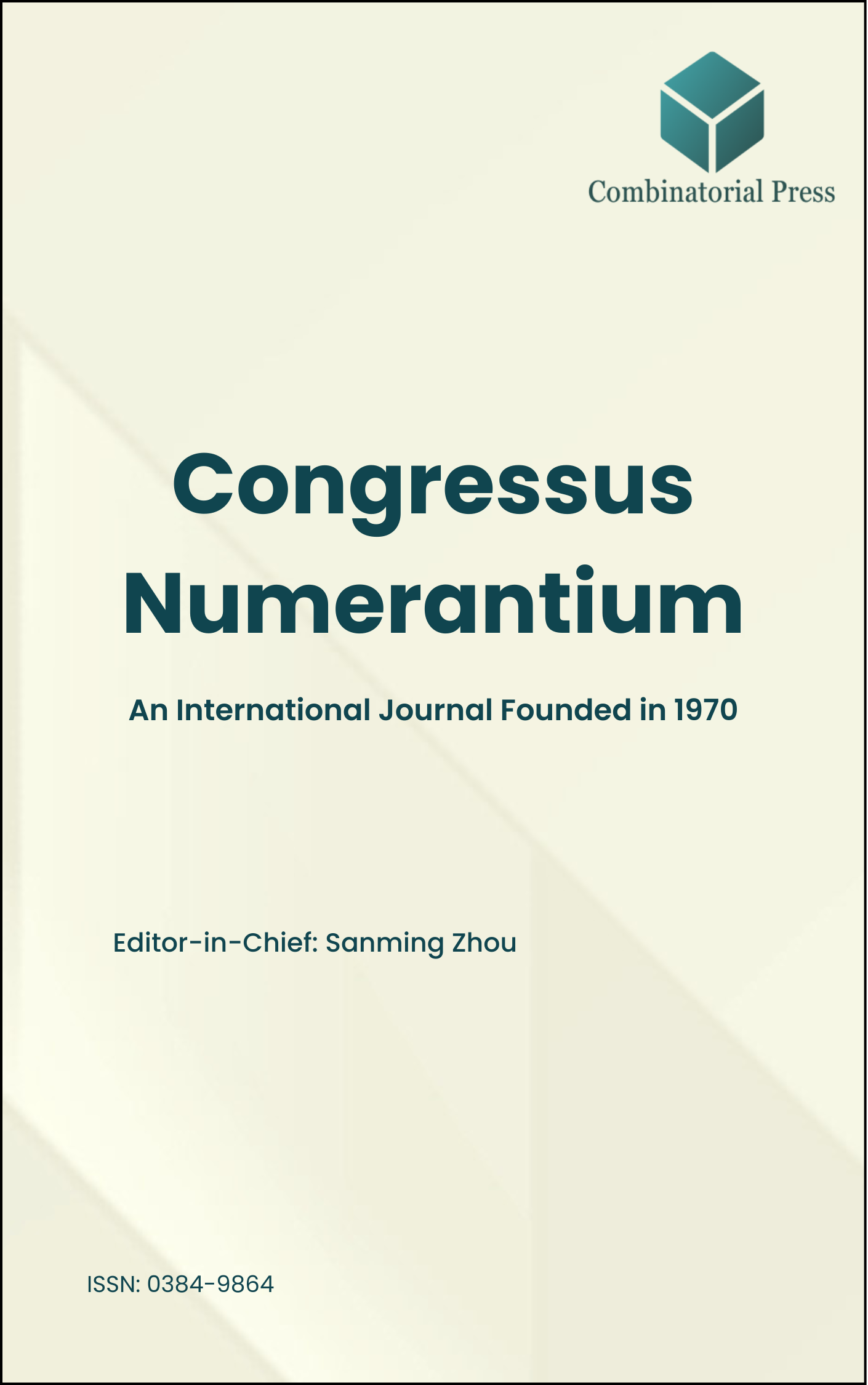
Congressus Numerantium
ISSN: 0384-9864
Established in 1970, Congressus Numerantium is one of the oldest international journals with a focus on publishing high-quality papers in combinatorics and related areas. Over the years, it has published numerous fully refereed regular papers and conference proceedings for many prestigious conferences. However, publication was temporarily paused on January 15, 2020. Throughout its active years, Congressus Numerantium adopted a print format, following a subscription-based model for readers and releasing 234 Volumes. Despite the changing landscape of academic publishing, Congressus Numerantium demonstrated resilience. In 2024, the journal embarked on a transformative journey, reemerging in both print and online formats with the objective of publishing 2 volumes annually, scheduled for release in June and December. We cordially invite original research papers and survey articles, welcoming significant contributions to both the pure and applied aspects of combinatorics. Furthermore, we extend a warm invitation for special issues dedicated to conferences and workshops in combinatorics and related fields, carrying forward the rich tradition of this esteemed journal. Special issues on selected topics of current interest to the community of combinatorics are also welcome.
- Research article
- Full Text
- Congressus Numerantium
- Volume 234
- Pages: 183-194
- Published: 31/12/2019
A set \( S \subseteq V \) is a dominating set of \( G \) if every vertex in \( V – S \) is adjacent to at least one vertex in \( S \). The domination number \( \gamma(G) \) of \( G \) equals the minimum cardinality of a dominating set \( S \) in \( G \); we say that such a set \( S \) is a \( \gamma \)-set.
A generalization of this is partial domination, which was introduced in 2017 by Case, Hedetniemi, Laskar, and Lipman. In \emph{partial domination}, a set \( S \) is a \( p \)-dominating set if it dominates a proportion \( p \) of the vertices in \( V \). The \( p \)-domination number \( \gamma_p(G) \) is the minimum cardinality of a \( p \)-dominating set in \( G \).
In this paper, we investigate further properties of partial dominating sets, particularly ones related to graph products and locating partial dominating sets. We also introduce the concept of a \( p \)-influencing set as the union of all \( p \)-dominating sets for a fixed \( p \) and investigate some of its properties.
- Research article
- Full Text
- Congressus Numerantium
- Volume 234
- Pages: 166-182
- Published: 31/12/2019
For bipartite graphs \( F \) and \( H \) and a positive integer \( s \), the \( s \)-bipartite Ramsey number \( BR_s(F,H) \) of \( F \) and \( H \) is the smallest integer \( t \) with \( t \geq s \) such that every red-blue coloring of \( K_{s,t} \) results in a red \( F \) or a blue \( H \). We evaluate this number for all positive integers \( s \) when \( F \) and \( H \) are both stars, are both matchings, or one is a star and the other is a matching, as well as when \( F = H \) is an arbitrary double star.
- Research article
- Full Text
- Congressus Numerantium
- Volume 234
- Pages: 161-165
- Published: 31/12/2019
In a graph \( G \), the Steiner distance \( d(S) \) of the vertex subset \( S \subseteq V(G) \) is the minimum size among all connected subgraphs whose vertex sets contain \( S \). The Steiner \( k \)-diameter of a connected graph \( G \) is the maximum \( d(S) \) among all \( k \)-element vertex subsets \( S \subseteq V(G) \).
In this paper, we examine the Steiner \( k \)-diameter for large \( k \) and then discuss the applications of the results.
- Research article
- Full Text
- Congressus Numerantium
- Volume 234
- Pages: 153-160
- Published: 31/12/2019
A set of vertices, \( S \), in a digraph \( D \), is split dominating provided it is:
- dominating and
- \( D[V(D) \setminus S] \) is either trivial or has a lower level of connection than \( D \).
In this paper, we consider split dominating sets in strongly connected tournaments. The split domination number of a strongly connected tournament \( T \), denoted by \( \gamma_s(T) \), is the minimum cardinality of a split dominating set for that tournament.
The authors previously gave a tight lower bound for \( \gamma_s(T) \) when \( T \) is regular. In this paper, we show that when \( T \) is a nearly regular \( 2k \)-tournament, then \( \gamma_s(T) \geq \lceil \frac{2k}{3} \rceil \) and this bound is tight.
- Research article
- Full Text
- Congressus Numerantium
- Volume 234
- Pages: 125-152
- Published: 31/12/2019
Redrawing lines for redistricting plans that represent U.S. congressional districts is a tricky business. There are many laws that dictate how lines can and cannot be drawn, such as contiguity. In fact, building all redistricting plans for a single U.S. state is an intractable problem. Researchers have turned to heuristics in order to analyze current redistricting plans. Many of these heuristics (e.g. local search heuristics and Markov chain Monte Carlo algorithms) used by researchers form new congressional districts by switching the smaller pieces (e.g. precincts or census blocks) that make up congressional districts from one congressional district to another.
In this paper, we discuss the various natural definitions involved in satisfying rules for contiguity and simply connectedness of precincts or census blocks and how these relate to contiguity and simply connectedness of congressional districts. We also propose and analyze several constructions to alleviate violations of contiguity and simply connectedness in precincts and census blocks. Finally, we develop efficient algorithms that allow practitioners to assess redistricting plans using local search heuristics or Markov chain Monte Carlo algorithms efficiently.
- Research article
- Full Text
- Congressus Numerantium
- Volume 234
- Pages: 115-124
- Published: 31/12/2019
A set \( S \subseteq V \) is \( \alpha \)-dominating if for all \( v \in V – S \), \( |N(v) \cap S| \geq \alpha |N(v)| \). The \( \alpha \)-domination number of \( G \) equals the minimum cardinality of an \( \alpha \)-dominating set \( S \) in \( G \). Since being introduced by Dunbar et al. in 2000, \( \alpha \)-domination has been studied for various graphs and a variety of bounds have been developed.
In this paper, we propose a new parameter derived by flipping the inequality in the definition of \( \alpha \)-domination. We say a set \( S \subset V \) is a \( \beta \)-packing set of a graph \( G \) if \( S \) is a proper, maximal set having the property that for all vertices \( v \in V – S \), \( |N(v) \cap S| \leq \beta |N(v)| \) for some \( 0 < \beta \leq 1 \). The \( \beta \)-\emph{packing number} of \( G \), denoted \( \beta\text{-pack}(G) \), equals the maximum cardinality of a \( \beta \)-packing set in \( G \).
In this research, we determine \( \beta\text{-pack}(G) \) for several classes of graphs, and we explore some properties of \( \beta \)-packing sets.
- Research article
- Full Text
- Congressus Numerantium
- Volume 234
- Pages: 95-114
- Published: 31/12/2019
A perfect matching of a graph is a subset of edges in the graph such that each vertex is contained in exactly one edge. We study the number of perfect matchings of a given graph. In particular, we are interested in the power of two that divides this number. A new type of vertex set, called a channel, is considered, whose presence is associated with powers of two in the perfect matching count. This provides a method for determining lower bounds on such powers. Algebraic and involutive proofs are given for these results, and methods for channel identification are provided. We specialize to perfect matchings on subgraphs of the square lattice, which are identified with domino tilings of the plane, and apply channels to some conjectures by Pachter.
- Research article
- Full Text
- Congressus Numerantium
- Volume 234
- Pages: 69-94
- Published: 31/12/2019
A dominating set of a graph \( G \) is a set of vertices \( D \) such that for all \( \nu \in V(G) \), either \( \nu \in D \) or \( [\nu,d] \in E(G) \) for some \( d \in D \). The cardinality-redundance of a vertex set \( S \), \( CR(S) \), is the number of vertices \( x \in V(G) \) such that \( |N[x] \cap S| \geq 2 \). The cardinality-redundance of \( G \) is the minimum of \( CR(S) \) taken over all dominating sets \( S \). A set of vertices \( S \) such that \( CR(S) = CR(G) \) is a \( \gamma_{CR} \)-set, and the size of a minimum \( \gamma_{CR} \)-set is denoted \( \gamma_{CR}(G) \).
Here, we are concerned with extremal problems concerning cardinality-redundance. We give the maximum number of edges in a graph with a given number of vertices and given cardinality-redundance. In the cases that \( CR(G) = 0 \) or \( 1 \), we give the minimum and maximum number of edges of graphs when \( \gamma_{CR}(G) \) is fixed, and when \( CR(G) = 2 \), we give the maximum number of edges of graphs where \( \gamma_{CR}(G) \) is fixed. We give the minimum and maximum values of \( \gamma_{CR}(G) \) when the number of edges are fixed and \( CR(G) = 0, 1 \), and we give the maximum values of \( \gamma_{CR}(G) \) when the number of edges are fixed and \( CR(G) = 2 \).
- Research article
- Full Text
- Congressus Numerantium
- Volume 234
- Pages: 61-68
- Published: 31/12/2019
It is known that for a maximal planar graph \( G \) with order \( n \geq 4 \), the independence number satisfies \( \frac{n}{4} \leq \alpha(G) \leq \frac{2n-4}{3} \). We show that the lower bound is sharp and characterize the extremal graphs for \( n \leq 12 \). For the upper bound, we characterize the extremal graphs of all orders.
The independence number \( \alpha(G) \) of a graph \( G \) is the size of the largest independent set. This parameter is difficult to determine in general, but can be bounded on various graph classes. This paper considers planar and maximal planar graphs.
- Research article
- Full Text
- Congressus Numerantium
- Volume 234
- Pages: 47-60
- Published: 31/12/2019
Constraint Programming (CP) is a method used to model and solve complex combinatorial problems. An alternative to Integer Programming for solving large-scale industrial problems, it is, under some circumstances, more efficient than IP, but its strength lies mainly in the use of predicates to model problems. This paper presents the at-least-\( m \)-different predicate and provides a class of facet-defining inequalities of the convex hull of integer solutions. This predicate bounds the number of values that variables in a set may receive. The paper also presents a polynomial-time separation algorithm to be used in the context of a branch-and-bound optimization approach.





